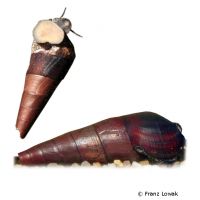Devil´s Thorn Snail (Faunus ater)
| Devil´s Thorn Snail Faunus ater | |
|---|---|
| Name | Devil´s Thorn Snail |
| Name Lat. | Faunus ater |
| Family | Pachychilids |
| Family lat. | Pachychilidae |
| Order | Caenogastropods |
| Order lat. | Caenogastropoda |
| Origin | Southeast Asia |
| Habitat | Streams, pools, estuaries |
| Diet | Omnivore |
| pH | 7.5-8.5 |
| Behavior | Peaceful |
| Keeping | Group |
| Care Level | Easy |
| Reproduction | Oviparous |
| Breeding | None reported |
| Life Span | 3-5 years |
| Protection | No |
| Metric Units | |
| Size | 6-8 cm |
| Temperature | 24-28 °C |
| Hardness | 5-20 °dH |
| Aquarium | ~ 60 l |
| US Units | |
| Size | 2.4"-3" |
| Temperature | 75-82 °F |
| Hardness | 89-356 ppm |
| Aquarium | ~ 15 gal |
Distribution and habitat
Devil's thorn snails are widely distributed from Sri Lanka to Thailand, Indonesia, the Philippines and northern Australia to New Guinea. They live in coastal streams, estuaries, brackish pools, tidal pools and mangrove swamps
Maintenance
They need a well-structured aquarium with roots, stones and plants. The burrowable substrate of sand or fine gravel should be partially covered with foliage (e.g. sea almond leaves, oak leaves), decaying plant material and mulm. Medium to hard, slightly alkaline water is ideal.
The water quality must correspond to that for the average keeping of freshwater fish. No ammonia, ammonium or nitrite should be detectable in the water and the nitrate value should be below 100 mg/l. When using a filter, make sure that only a weak current is created and that no animals can be sucked in. The lighting must correspond to the natural day-night rhythm of the animals.
Diet
Devil's thorn snails feed on dead plant material (detritus) and algae growth. The food supply consists of algae leaves, over-broken lettuce or dry food (flakes, food tablets) with high vegetable content (spirulina), which is usually accepted after habituation.
Feeding should be varied to prevent the occurrence of deficiency symptoms. Unaccepted food must be removed after 2-3 hours
Behaviour and compatibility
They should be kept in a small group of 4-6 devil's thorn snails. Socialization with fish and other invertebrates that do not consider these snails as food is well possible
Basically, only mutually compatible species with similar requirements for water conditions and water temperature should be socialized.
Reproduction and breeding
They are separately sexed. The sexes can not be distinguished from each other externally
After mating, the female sticks the egg capsules to various substrates. Each of these capsules contains numerous eggs from which swimmable larvae hatch and live for some time as part of the marine plankton in the sea. As they grow, they then form their shells, switch to a crawling lifestyle, and return to the estuaries. There are no known reports of successful breeding in the aquarium.
Important
In the wide range of the devil's dor snails there are some color variations
Adult animals sometimes bury themselves in the sand for days
To build up their shells they need a sufficient supply of lime. Especially in soft, acidic water, shell damage (holes) can occur due to lack of calcium, which can lead to the death of the snail. Therefore, special attention should be paid to the calcium concentration in the water and, if necessary, calcium should be added in the form of limestone, cuttlebone or special preparations from the specialized trade
The foliage (sea almond tree, oak, beech, etc.) not only provides cover, but when rotting promotes the development of microorganisms, which are a valuable secondary food source.
The well-being of the animals should be monitored regularly. Temperature should be checked daily, pH, hardness and nitrate levels at least every 14 days. Regular partial water changes are recommended, even when contaminant levels have not yet reached the upper limit. Sudden changes in water quality should be avoided. Newly introduced animals must be accustomed slowly to the water in the aquarium.
Further literature can be found in your pet store.
References
Text: Barbara Pachner; Image: Franz Lowak
Source: BITTER (2008), Schnecken-Fibel, Dähne Verlag; ENGELMANN & LANGE (2011): Zootierhaltung - Tiere in menschlicher Obhut: Wirbellose, Verlag Harri Deutsch
